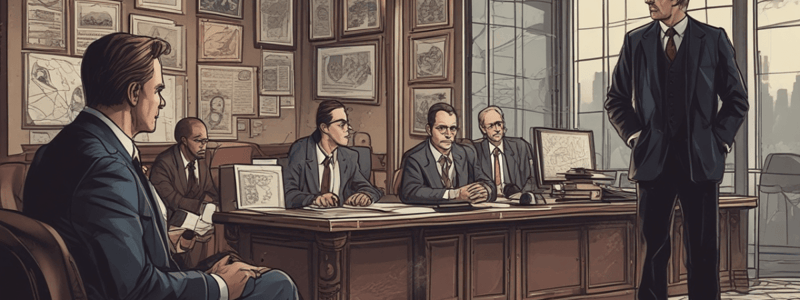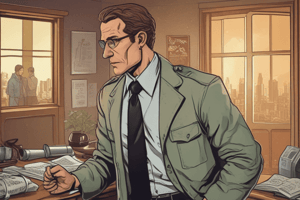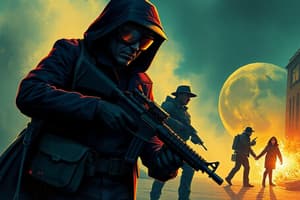Podcast
Questions and Answers
What is the primary purpose of a pretrial meeting?
What is the primary purpose of a pretrial meeting?
- To discuss the admissibility of evidence
- To manufacture evidence to fill in for any missing elements
- To prepare for a successful prosecution (correct)
- To identify potential weaknesses in the case
What should you do before a pretrial meeting?
What should you do before a pretrial meeting?
- Identify potential weaknesses in the case
- Thoroughly review all available case documentation (correct)
- Enhance facts to fill in for any missing elements
- Discuss the case with only your supervisor
What should you do during a pretrial meeting?
What should you do during a pretrial meeting?
- Discuss only the strengths of the case
- Refuse to provide details on the case
- Remain truthful, honest, and accurate when discussing the case (correct)
- Manufacture evidence to support the facts
What should you be prepared to discuss during a pretrial meeting?
What should you be prepared to discuss during a pretrial meeting?
What should you do if you identify potential weaknesses in the case?
What should you do if you identify potential weaknesses in the case?
What is your continuing obligation as an officer?
What is your continuing obligation as an officer?
What should you consider when preparing for a pretrial meeting?
What should you consider when preparing for a pretrial meeting?
What should you do if you identify any special issues or situations in the case?
What should you do if you identify any special issues or situations in the case?
Why should you separate the victims, complainants, and witnesses at a crime scene?
Why should you separate the victims, complainants, and witnesses at a crime scene?
What should you do with vital witnesses at a crime scene?
What should you do with vital witnesses at a crime scene?
What should you do if the judge sustains the objection?
What should you do if the judge sustains the objection?
What information should you document about the people involved in the crime?
What information should you document about the people involved in the crime?
What type of question requires you to make a decision on an issue?
What type of question requires you to make a decision on an issue?
Why should you ask the victim or complainant to name potential witnesses?
Why should you ask the victim or complainant to name potential witnesses?
What is an example of an irrelevant question?
What is an example of an irrelevant question?
What should you do if you are asked an objectionable question?
What should you do if you are asked an objectionable question?
What is a possible controlled area to separate witnesses?
What is a possible controlled area to separate witnesses?
Why is it important to separate witnesses who experienced the same event?
Why is it important to separate witnesses who experienced the same event?
What is a tactic used by a defense attorney to discredit you?
What is a tactic used by a defense attorney to discredit you?
What should you do if separate rooms are not available to isolate witnesses?
What should you do if separate rooms are not available to isolate witnesses?
How should you respond to a confrontational or badgering defense attorney?
How should you respond to a confrontational or badgering defense attorney?
What is the goal of a defense attorney's tactic of asking the same question multiple times?
What is the goal of a defense attorney's tactic of asking the same question multiple times?
What should you tell witnesses not to do after separating them?
What should you tell witnesses not to do after separating them?
What should you do if you are unsure about how to respond to a question?
What should you do if you are unsure about how to respond to a question?
What is the purpose of filler photographs in a photo array?
What is the purpose of filler photographs in a photo array?
What is the ideal characteristic of a lineup administrator?
What is the ideal characteristic of a lineup administrator?
What is the purpose of using an automated computer program to administer a photo lineup?
What is the purpose of using an automated computer program to administer a photo lineup?
What should the lineup administrator do when presenting the photographs to the witness?
What should the lineup administrator do when presenting the photographs to the witness?
What is the purpose of using randomly numbered, shuffled folders in a photo lineup?
What is the purpose of using randomly numbered, shuffled folders in a photo lineup?
Why is it important to have an independent lineup administrator?
Why is it important to have an independent lineup administrator?
What should the lineup administrator avoid doing during the lineup procedure?
What should the lineup administrator avoid doing during the lineup procedure?
What is the ultimate goal of the lineup structure?
What is the ultimate goal of the lineup structure?
What is a primary goal when evaluating leads?
What is a primary goal when evaluating leads?
What type of lead is typically considered high-priority?
What type of lead is typically considered high-priority?
Why is it important to re-canvass the area surrounding the incident or crime scene?
Why is it important to re-canvass the area surrounding the incident or crime scene?
What is a field contact?
What is a field contact?
Why is it important to evaluate field contact information carefully?
Why is it important to evaluate field contact information carefully?
What can be a benefit of re-canvassing the same homes or businesses?
What can be a benefit of re-canvassing the same homes or businesses?
What is a common source of information in an investigation?
What is a common source of information in an investigation?
What should you remember when interviewing medical personnel?
What should you remember when interviewing medical personnel?
What is the purpose of the good-faith exception doctrine?
What is the purpose of the good-faith exception doctrine?
What type of communications are protected by privileged communication?
What type of communications are protected by privileged communication?
What is the primary goal of a crime scene investigation?
What is the primary goal of a crime scene investigation?
What should you do when arriving at a crime scene?
What should you do when arriving at a crime scene?
What is the focus of the preliminary investigation?
What is the focus of the preliminary investigation?
Why should you prioritize securing and protecting the crime scene?
Why should you prioritize securing and protecting the crime scene?
What is the role of a crime scene investigator?
What is the role of a crime scene investigator?
What is the ultimate goal of a crime scene investigation?
What is the ultimate goal of a crime scene investigation?
When should you take immediate action to arrest a wanted person?
When should you take immediate action to arrest a wanted person?
What is the purpose of a showup?
What is the purpose of a showup?
Why is it important to separate victims or witnesses during a showup?
Why is it important to separate victims or witnesses during a showup?
What should you do before conducting a showup?
What should you do before conducting a showup?
What type of support can assist in searching for a wanted person?
What type of support can assist in searching for a wanted person?
What is the goal of a showup?
What is the goal of a showup?
Where should a showup typically occur?
Where should a showup typically occur?
Why should you use a showup in an immediate situation?
Why should you use a showup in an immediate situation?
What is the primary purpose of photographing a crime scene?
What is the primary purpose of photographing a crime scene?
What is the sequence of crime scene photography?
What is the sequence of crime scene photography?
What is included in close-up shots of evidence?
What is included in close-up shots of evidence?
Why are photographs of the crime scene important?
Why are photographs of the crime scene important?
What is the first step in documenting a crime scene?
What is the first step in documenting a crime scene?
What is the purpose of an overall photograph of the crime scene?
What is the purpose of an overall photograph of the crime scene?
What is the purpose of midrange photographs?
What is the purpose of midrange photographs?
What is the purpose of documenting the crime scene?
What is the purpose of documenting the crime scene?
What should the eyewitness be told during the lineup process?
What should the eyewitness be told during the lineup process?
What should be documented during the lineup process?
What should be documented during the lineup process?
Why is it important to preserve the entire photo array as evidence?
Why is it important to preserve the entire photo array as evidence?
What should you do if you are scheduled to testify in court on a case that happened over six months ago?
What should you do if you are scheduled to testify in court on a case that happened over six months ago?
What is the goal of Lesson 1: Testimony?
What is the goal of Lesson 1: Testimony?
Why can testifying in court be a stressful experience?
Why can testifying in court be a stressful experience?
What may happen during cross-examination?
What may happen during cross-examination?
What is the purpose of carefully documenting the lineup process?
What is the purpose of carefully documenting the lineup process?
What is the goal of a defense attorney's tactic of rapid-fire questioning?
What is the goal of a defense attorney's tactic of rapid-fire questioning?
How should you respond to a defense attorney's mispronunciation of your name or title?
How should you respond to a defense attorney's mispronunciation of your name or title?
What is the purpose of a defense attorney's tactic of building rapport with the witness?
What is the purpose of a defense attorney's tactic of building rapport with the witness?
What should you do when a defense attorney asks you multiple questions at once?
What should you do when a defense attorney asks you multiple questions at once?
Why does a defense attorney try to lead you to say that you are an expert?
Why does a defense attorney try to lead you to say that you are an expert?
What should you focus on when responding to a defense attorney's questions?
What should you focus on when responding to a defense attorney's questions?
Why does a defense attorney try to intimidate you?
Why does a defense attorney try to intimidate you?
What should you do when a defense attorney asks you a question that you are unsure about?
What should you do when a defense attorney asks you a question that you are unsure about?
Flashcards are hidden until you start studying
Study Notes
Identifying Witnesses and Gathering Information
- Ask victims, complainants, or witnesses to name potential witnesses of the incident.
- Document the names, dates of birth, genders, races, addresses, and telephone numbers of all people involved.
- Separate involved people to prevent them from coordinating their accounts of what happened.
- Keep them in separate locations, ideally far enough apart so they cannot hear or see each other.
Determining the Value and Validity of Leads
- Evaluate and document all leads to determine their value and prioritize them for follow-up based on content.
- High-priority leads include latent fingerprint identification and DNA that identify a suspect.
- Low-priority leads include anonymous tips with little detail, but they may still produce valuable information.
Field Contacts and Confidential Sources of Information
- Field contacts are common sources of information, developed through community policing, and can assist in completing an investigation.
- Evaluate field contact information carefully, considering who the contact is and their relationship to the victim or suspect.
Developing a Photo Array
- A photo array should include filler photographs of people other than the suspect, with physical characteristics similar to those of the suspect.
- Each photograph in the array should be of a different person, formatted alike.
Conducting a Lineup
- The lineup administrator should be independent of the investigation and unaware of which person in the lineup is the suspect.
- The lineup administrator should conduct the lineup and provide instructions to the victim or witness.
- Use accepted procedures for conducting a photo lineup, such as an automated computer program or randomly numbered, shuffled folders.
Preparing for a Pretrial Meeting
- Thoroughly review all available case documentation before a pretrial meeting.
- Discuss the case with appropriate agency personnel, such as supervisors, watch commanders, or crime scene and evidence personnel.
- Be prepared to discuss who, what, when, where, how, and why facts of the case, all evidence, and any other relevant information.
Responding to Objectionable Questions
- If the judge sustains an objection, do not answer the question.
- If the judge overrules the objection, answer the question truthfully.
- Be aware of types of objectionable questions, such as those that call for a conclusion or are irrelevant to the case.
Cross-Examination Tactics
- Be aware of defense attorney tactics to discredit, misrepresent, or confuse you during a criminal trial.
- Use techniques to overcome these tactics, such as conveying professionalism, knowledge, and confidence, and giving firm, decisive answers.
Crime Scene Investigation
- The good-faith exception doctrine allows evidence to be admitted in court even if the search warrant is later found to have a legal error, as long as the officer executing the warrant believed it was valid.
- Privileged communications are protected from disclosure, including those between a sexual assault counselor and victim, or a domestic violence advocate and victim.
Securing and Protecting the Crime Scene
- The purpose of an investigation is to determine what happened, identify and locate the suspect, and develop evidence to establish probable cause for an arrest.
- The preliminary investigation focuses on establishing whether a criminal act has been committed and what type, when, and where it was committed.
Documenting the Crime Scene
- Photographing the crime scene is the first step in documenting, and it allows people who were not present to gather information and visualize the scene.
- The photography process moves from general to specific, starting with overall shots, then midrange shots, and finally close-up shots with a scale or identifier.
Conducting a Showup, Photographic Array, and Photo Lineup
- A showup is the presentation of a possible suspect to a witness for identification, and it occurs during or soon after the incident, near the crime scene.
- A showup is used in immediate situations, such as battery or robbery by sudden snatching, and can lead to an immediate arrest.
- Before conducting a showup, interview all victims or witnesses separately to obtain a description of the suspect.
- Use a showup in a controlled environment, such as separate patrol vehicles, to avoid the potential suspect from being able to see the victim or witness.
Lineup Procedures
- Eyewitness instructions:
- The perpetrator might or might not be in the lineup.
- The lineup administrator does not know the suspect's identity.
- The witness should not feel compelled to make an identification.
- It is as important to exclude innocent persons as it is to identify the perpetrator.
- The investigation will continue with or without the witness's identification.
- Carefully document or record any comments made by the witness during the lineup process.
- Note any non-verbal communication or action of the witness in the investigative file.
- If the witness makes an identification, document the precise photograph selected.
Preparing for Court
- Testifying in court can be a stressful experience, and it is essential to prepare for it.
- When testifying, remember to:
- Pause and stay calm in response to challenging questions.
- Ask the attorney to repeat questions one at a time and take time to consider each question.
- Speak deliberately and remain calm.
- Stay alert and control your ego to avoid being led into giving inconsistent answers.
- Focus on the facts of the case and avoid being distracted by the attorney's statements or questions.
- Politely correct the attorney if they mispronounce your name, title, or rank.
Studying That Suits You
Use AI to generate personalized quizzes and flashcards to suit your learning preferences.




